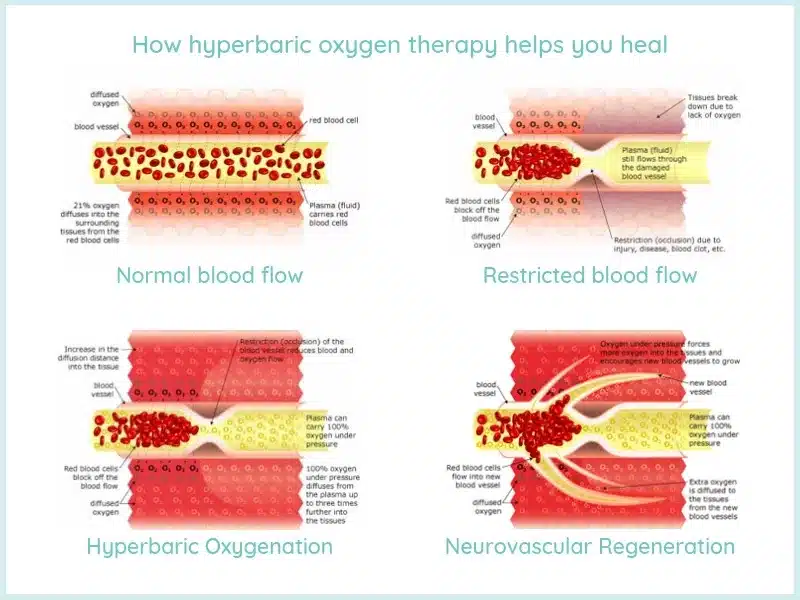

Hyperbaric Oxygen Therapy (HBOT)

Hyperbaric Oxygen Therapy (HBOT)
It is the breathing of 100 % oxygen while inside a treatment chamber, at a pressure higher than sea level pressure (ie, greater than 1 atmosphere absolute; ATA). The treatment may be carried out in a monoplace chamber. The chamber accommodates a single patient and the entire chamber is pressurized with 100 % oxygen, which the patient breathes directly. By providing pure oxygen in a pressurized chamber we are able to deliver 10 – 15 times more oxygen then if delivered at sea level or at normal atmospheric levels.
Some of the effects this has are to promote the growth of new blood vessels, decreases swelling and inflammation, deactivates toxins, increase the body’s ability to fight infections, clears out toxins and metabolic waste products, and improve the rate of healing. HBOT should be used to complement conventional therapies and treatments.
Benefits of HBOT
1. HBOT is very cost-effective.
2. HBOT is non-invasive.
3. HBOT is safe.
4. HBOT works well with other treatments.
What is a hyperbaric chamber?
It is a container/vessel/room built to withstand an increased internal pressure. They are generally cylindrical, spherical, or rectangular. Multiplace chambers are usually constructed in steel and monoplace units are mainly acrylic. Multiplace chambers have port-holes or small windows and comfortable seating is provided.Our large rectangular chamber is approximately 6m x 3m x 2m and is our main treatment room. Access is via a door that is large enough to walk through or wheel a special hyperbaric trolley. It has a toilet available for urgent use. Out smaller chamber is cylindrical measuring 3m long x 2 m diameter and is usually reserved for acute diving-related injuries. Both chambers are twin-lock units, which enable personnel to enter or leave while the main treatment continues.

How does HBOT work?

The air we breathe is 21% oxygen, 79% nitrogen, and minor amounts of other gases. Our bodies are usually able to heal themselves with a normal oxygen level, but in certain conditions, extra oxygen is required. During HBO therapy, the pressure is increased to 2 – 3 times that of sea-level and you breathe 100% oxygen. The breathing of pure oxygen under pressure causes a much larger than normal amount of oxygen to be dissolved in the blood and, subsequently, the rest of the body.
The extra oxygen is used by the body in many ways. Depending on the underlying problem, the actions can include improved wound healing by reduction of swelling, infection control, and the stimulation of new blood vessel growth. In dysbaric injuries, there is a reduction in gas bubble size and a reduction in the body’s response to that injury.
Side effects are uncommon. They relate to the increase in pressure (ear or lung barotrauma) or the use of increased amounts of oxygen (CNS or lung oxygen toxicity). Some patients may also experience visual changes that cause them to become more near-sighted (myopia); this is usually temporary and should disappear within 3-4 months of ceasing therapy. Your doctor will discuss these prior to your commencing treatment and at any time you are concerned.
If at any time during the treatment you feel uncomfortable or have any sensation that is not normal for you, please report it to the nurse, immediately. At the end of the treatment, the chamber pressure is reduced to the usual atmospheric pressure end the air will feel colder. You will feel your ears “popping” during the phase.
Except for decompression sickness and arterial gas embolism, the typical treatments are approximately two hours long. Treatments are administered on an in-patient or out-patient basis. In some acute cases, treatments may be administered every eight to twelve hours.
A patient’s clinical response and other factors often dictate the number of treatments required. Emergency cases, such as carbon monoxide poisoning, arterial gas embolism, or decompression sickness, may only require one or two treatments. Non-healing wounds may call for as many as 20 to 30 treatments.
Generally, the patient will not feel differently. However, during certain parts of the treatment, the patient may experience a sensation of fullness in the ears, similar to the feeling experienced on an airplane. This is a result of the eardrum responding to pressures changes. Prior to treatment, the patient will be taught a few easy methods to “clear” his or her ears to avoid discomfort.
It is possible to read, talk, rest, sleep or play cards or other games with the other patients or staff. There will be a short break during the treatment when it may be possible to have some refreshments.

